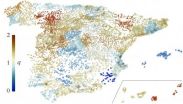(Press-News.org) Medical researchers at the University of Alberta have made a discovery that may explain how prion diseases, like chronic wasting disease and mad cow disease, adapt in order to spread between various types of animals.
The research team, led by neurologist Valerie Sim, discovered that a miniscule change in the prions' makeup appears to give the disease the ability to adapt – to mimic and recreate new strains with which it comes into contact. The team has been studying this area for two years.
"Prion diseases don't always successfully go from one animal to another, but when they do, the process is called adaptation. And we want to figure out what triggers that process to happen, what changes happen within prions to allow the disease to spread," says Sim, a researcher with the Faculty of Medicine & Dentistry, whose discovery was recently published in the peer-reviewed Journal of Biological Chemistry.
"One of the important things researchers in this field have realized is that if you pass certain strains of prion disease through a number of different hosts, the disease can adapt along the way and increase the number of susceptible hosts. That's the big concern right now.
"We want to determine why one prion disease might be able to spread from one type of animal to another and why another strain of the disease can't."
For instance, if a deer with chronic wasting disease is scavenged by another animal, could the prion disease cross into that intermediate host, evolve and then infect animals or species typically not at direct risk for the disease.
"We hope to understand how these bigger issues develop," says Sim. "We need to pay attention to chronic wasting disease in particular because it has the ability to spread in a different way than mad cow disease. Chronic wasting disease prions can be deposited into the soil and stay there for years, and could be eaten by another animal. How does it evolve from there then?"
Sim and her team are continuing their research in this area and are seeing impressive results in the lab – reconfirming their findings through the testing of additional models.
Sim works in the Department of Medicine in the Division of Neurology. She is cross-appointed to the Centre for Neuroscience and the Centre for Prions and Protein Folding Diseases.
Her team's research was funded by Alberta Innovates – Health Solutions (AIHS), PrioNet Canada and the Alberta Prion Research Institute.
"Dr. Sim's achievements in prion research are of particular significance to Albertans," says Pamela Valentine, Acting CEO of AIHS. "She is truly a world class researcher and we are delighted that our funding was instrumental in recruiting her back to Alberta nearly eight years ago."
The Alberta Prion Research Institute had similar sentiments about the discovery.
"We are proud to support Dr. Valerie Sim and her research on prion biology and the mechanisms that lead to prion diseases," said Kevin Keough, Executive Director, Alberta Prion Research Institute (APRI).
"APRI will continue to partner with the Centre for Prion and Protein Folding Diseases and other Alberta-based researchers to focus on research and discoveries that will lead towards diagnoses, treatments and eventual cures of prion and prion-like diseases."
PrioNet Canada agreed: "We are very pleased to have supported Dr. Sim's important work, which is at the forefront of understanding the strange biology of prions," said Neil Cashman, Scientific Director of PrioNet Canada. "Her research will help point the way to predict and manage the deadly impacts of prion diseases."
### END
Discovery may explain how prion diseases spread between different types of animals
2013-03-11
ELSE PRESS RELEASES FROM THIS DATE:
Untangling life's origins
2013-03-11
URBANA – Researchers in the Evolutionary Bioinformatics Laboratory at the University of Illinois in collaboration with German scientists have been using bioinformatics techniques to probe the world of proteins for answers to questions about the origins of life.
Proteins are formed from chains of amino acids and fold into three-dimensional structures that determine their function. According to crop sciences professor Gustavo Caetano-Anollés, very little is known about the evolutionary drivers for this folding.
In collaboration with scientists at the Heidelberg Institute ...
The dynamic of Spain's population follows the maximum entropy principle
2013-03-11
A team of Spanish and Argentinean researchers have verified that the distribution of the inhabitants in each Spanish province evolves in accordance with the maximum entropy principle in the field of physics. Therefore, this evolution is predictable. The results have allowed authors to put forward a 'socio-thermodynamic' theory that applies the laws of thermodynamics to collective human behaviour.
Spanish and Argentinean scientists have researched the way in which we as people group together on a large scale as a way of seeing whether there is any law or pattern that explains ...
Ground-level ozone falling faster than model predicted
2013-03-11
There is good news and better news about ground-level ozone in American cities. While dangerous ozone levels have fallen in places that clamp down on emissions from vehicles and industry, a new study from Rice University suggests that a model widely used to predict the impact of remediation efforts has been too conservative.
Particularly in Northeastern cities, ozone levels dropped even beyond what was anticipated by cutting emissions of nitrogen oxides (NOx) from 2002 to 2006. The study published online by the journal Atmospheric Environment suggests the Community Multiscale ...
Can energy drinks improve the physical and mental performance of cyclists?
2013-03-11
New Rochelle, NY, March 11, 2013–Consumption of energy drinks containing caffeine may have beneficial effects on exercise but probably not for mental function. The effects of pre-exercise caffeine consumption by trained cyclists on racing times and cognitive performance were measured and are reported in Journal of Caffeine Research, a peer-reviewed journal from Mary Ann Liebert, Inc., publishers. The article is available free on the Journal of Caffeine Research website at http://www.liebertpub.com/jcr.
Race performance improved for all study participants after consuming ...
Common MS drugs taken together do not reduce relapse risk
2013-03-11
A recent clinical trial found that interferonβ-1a (INF) and glatiramer acetate (GA), two of the most commonly prescribed drugs for multiple sclerosis (MS), provide no additional clinical benefit when taken together. While findings published today in Annals of Neurology, a journal of the American Neurological Association and Child Neurology Society, suggest that taking both INF and GA together was not superior to GA monotherapy in reducing relapse risk; the combination therapy does appear to reduce new lesion activity and total lesion volume.
The National Institute ...
The closest star system found in a century
2013-03-11
A pair of newly discovered stars is the third-closest star system to the Sun, according to a paper that will be published in Astrophysical Journal Letters. The duo is the closest star system discovered since 1916. The discovery was made by Kevin Luhman, an associate professor of astronomy and astrophysics at Penn State University and a researcher in Penn State's Center for Exoplanets and Habitable Worlds.
Both stars in the new binary system are "brown dwarfs," which are stars that are too small in mass to ever become hot enough to ignite hydrogen fusion. As a result, ...
Stroke risk in elderly treated with antipsychotics is newly linked to specific drug actions
2013-03-11
Philadelphia, PA, March 11, 2013 – Antipsychotic administration in the elderly is associated with an increased risk for cerebrovascular accident, more commonly known as stroke; a new study published in Biological Psychiatry provides additional insight into this important relationship.
Antipsychotics are prescribed to elderly patients to treat symptoms such as agitation, psychosis, anxiety, insomnia, and depression. The increased risk of stroke associated with these medications was identified approximately a decade ago and has since been replicated by subsequent studies. ...
Biodiesel algae: Starvation diets damage health
2013-03-11
It may be better to tolerate lower oil content in algae grown for biodiesel to boost growth and overall productivity, says research from the University of Sheffield.
The research shows that the commonly accepted method of depriving algae of key nutrients such as nitrogen in order to boost its oil content may be detrimental to overall oil yield in the long term.
"Total oil production depends not just on the oil content of the algal cells but how quickly the cells grow and multiply," says Dr Stephen Wilkinson of the University's Department of Chemical and Biological ...
Need for culturally sensitive treatment for deaf patients with psychiatric disorders
2013-03-11
Philadelphia, Pa. (March 11, 2013) – Members of the Deaf community who suffer from mental health problems need culturally sensitive treatment to avoid misdiagnosis and inappropriate treatment, according to a report in the March Journal of Psychiatric Practice. The journal is published by Lippincott Williams & Wilkins, a part of Wolters Kluwer Health.
"Deaf individuals comprise a cultural and linguistic minority group within the United States, and culturally and linguistically appropriate psychiatric treatment must reflect these differences," according to Sarah A. Landsberger, ...
Study finds fat and bone mass are genetically linked
2013-03-11
When it comes to body shape, diet and exercise can only take us so far. Our body shape and geometry are largely determined by genetic factors. Genetics also have an impact on our body composition – including soft fat tissue and hard bone tissue – and can lead to excess fat or osteoporosis.
Now Prof. Gregory Livshits of Tel Aviv University's Department of Anatomy and Anthropology at the Sackler Faculty of Medicine, working alongside Dr. Michael Korostishevsky, has uncovered a clear genetic link between fat and bone mass. These factors, which contribute to bone metabolism, ...


